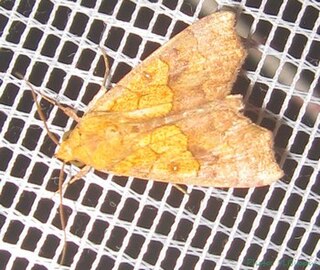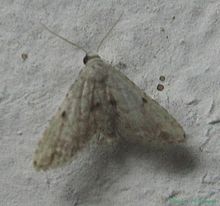Sir George Francis Hampson, 10th Baronet was an English entomologist.

Acronicta is a genus of noctuid moths containing about 150 species distributed mainly in the temperate Holarctic, with some in adjacent subtropical regions. The genus was erected by Carl Linnaeus in his 1758 10th edition of Systema Naturae. Caterpillars of most Acronicta species are unmistakable, with brightly colored hairy spikes, and often feed quite visibly on common foliate trees. The hairy spikes may contain poison, which cause itchy, painful, swollen rash in humans on contact. The larva of the smeared dagger moth is unusually hairy even for this genus. Acronicta species are generally known as dagger moths, as most have one or more black dagger-shaped markings on their forewing uppersides. But some species have a conspicuous dark ring marking instead.

Nola is a genus of moths described by William Elford Leach in 1815. They are the namesake of the subfamily Nolinae and the family Nolidae. This genus occurs worldwide wherever suitable habitat is present.

Scoparia is a grass moth genus of subfamily Scopariinae. Some authors have assigned the synonymous taxon Sineudonia to the snout moth family (Pyralidae), where all grass moths were once also included, but this seems to be in error.

Anomis is a genus of moths in the family Erebidae.
Araeopterella is a monotypic moth genus of the family Noctuidae. Its only species, Araeopterella miscidisce, is found in Panama. Both the genus and species were first described by Harrison Gray Dyar Jr. in 1914.

Autoba is a genus of moths of the family Erebidae. The genus was erected by Francis Walker in 1863.

Corgatha is a genus of moths of the family Erebidae erected by Francis Walker in 1859.

Iambia is a genus of moths of the family Noctuidae. The genus was erected by Francis Walker in 1863.

Eublemma is a genus of moths of the family Erebidae described by Jacob Hübner in 1829.

Hypenodes is a genus of moths of the family Erebidae erected by Henry Doubleday in 1850.

Leucania is a genus of moths of the family Noctuidae first described by Ferdinand Ochsenheimer in 1816.
Leucotelia is a monotypic moth genus of the family Erebidae erected by George Hampson in 1926. Its only species, Leucotelia ochreoplagata, was first described by George Hamilton Kenrick in 1917. It is found on Madagascar.

Lygephila is a genus of moths in the family Erebidae. The genus was erected by Gustaf Johan Billberg in 1820.
Metachrostis is a genus of moths of the family Erebidae first described by Jacob Hübner in 1820.

Rivula is a genus of moths in the family Erebidae described by Achille Guenée in 1845.

Amolita irrorata is a species of moth in the family Erebidae first described by George Hampson in 1910. The species is found in South America, including Paraguay and Brazil. Its wingspan is 26–32 mm (1.0–1.3 in).

The Erebinae are a subfamily of moths in the family Erebidae erected by William Elford Leach in 1815. Erebine moths are found on all continents except Antarctica, but reach their greatest diversity in the tropics. While the exact number of species belonging to the Erebinae is not known, the subfamily is estimated to include around 10,000 species. Some well-known Erebinae include underwing moths (Catocala) and witch moths (Thermesiini). Many of the species in the subfamily have medium to large wingspans, up to nearly 30 cm in the white witch moth, which has the widest wingspan of all Lepidoptera. Erebine caterpillars feed on a broad range of plants; many species feed on grasses and legumes, and a few are pests of castor bean, sugarcane, rice, as well as pistachios and blackberries.













